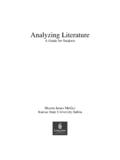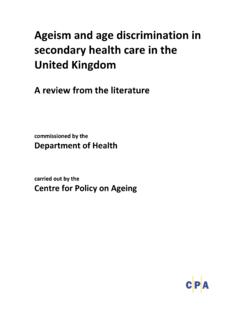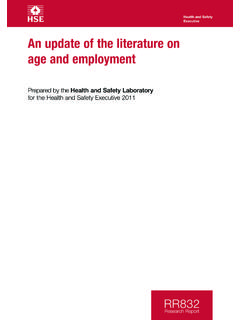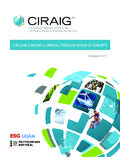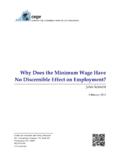Transcription of Strengths and weaknesses of available methods for ...
1 _____ 1 Strengths and weaknesses of available methods for assessing the nature and scale of harm caused by the health system: literature review By Philippe Michel WHO commissioned Philippe Michel of the Comit de Coordination de l valuation Clinique et de la Qualit en Aquitaine (CCECQA) to carry out a literature review on methods for assessing the nature and scale of harm caused by health systems. The objective of the study was to identify the Strengths and weaknesses of available methods . The study, which was completed in December 2003, is a contribution to the discussion of patient safety issues. The author alone is responsible for the views expressed in this paper. He is grateful to Jean Luc Quenon (CCECQA) who wrote the sections dealing with reporting systems, and with claims and complaints, and is indebted to Charles Vincent for his useful comments. He wishes to thank Emmanuelle Blondet, Sylvie Lascols and Vincent Mounic, of the Agence Nationale d Accr ditation et d Evaluation en Sant (ANAES), France, for their help in the literature search and retrieval.
2 _____ 2 Contents Abstract 4 1 Introduction 7 Objective 8 2 literature review 8 Study design 8 Search strategy for articles 8 Selection criteria for articles 9 Definitions 9 Criteria for evaluating assessment methods 10 Data analysis 11 Results of the literature search 13 3 Strengths and weaknesses of available methods 16 Review of medical records 16 Studies based on interviews with health-care providers 22 Direct observation 24 Incident reporting systems 26 External audit and confidential inquiries 30 Studies of claims
3 And complaints 32 Information technology and electronic medical records 35 Administrative data 38 Autopsy reports 40 Mortality and morbidity conferences 42 4 Focus on the literature from developing countries and transitional economies 44 5 Discussion and conclusions 49 References 50 _____ 3 ABSTRACT This report describes the Strengths and weaknesses of available methods for assessing the nature and scale of harm caused by the health system, according to a defined set of criteria. These criteria, and the available methods , were identified during a WHO Working Group meeting on Patient safety: rapid assessment methods for assessing hazards, held in Geneva, Switzerland, 17-19 December 2002.
4 Study design The author and his colleagues conducted an extensive search of the Medline database and other sources to identify methods for estimating hazards. methods included: ad hoc studies based on epidemiological designs and systematic data collection (review of medical records, studies based on interviews with health care providers, direct observation); institutional and national reporting systems; external audits and confidential enquiries; analysis of existing and routinely collected data (studies of claims and complaints; information technology and electronic medical records; administrative data; autopsy reports; and mortality and morbidity conferences). The criteria used to select methods for the present study were effectiveness in capturing: the extent of harm; availability of reliable data; suitability for large-scale or small, repeated studies; costs (financial, human resources, time and burden on system); effectiveness in influencing policy; effectiveness in influencing hospital and local safety procedures and outcomes; and synergy with other domains of quality of care.
5 We considered the level of evidence of published literature for rating each method on each of the criteria. When evidence-based data were available , we used a four-item scale (from + to ++++). In the absence of valid data, we presented the results in a separate table using a different rating presentation (from 1 to 4), reflecting authors opinions. Both ratings were considered in relation to information-rich environments. In a separate analysis, we considered the literature from developing countries. Here the small number of articles did not make it possible to extract sufficient evidence-based data, and the opinion-based rating from 1 to 4 was used. Results A total of 262 articles were selected for inclusion in the study, from 1828 retrieved references. The relevance of each method is summarized in Table 1 according to the purpose of the user, defined in terms of scope (harm, active error or latent error) and objective (adverse event counting or understanding).
6 Table 1 Overview of methods with respect to their relevance for specific purposes Adverse event counting (frequency assessment) Method Harm Active errors Adverse event understanding (root cause analysis) latent causes / contributory factors Review of medical records X X ? Studies based on interviews with health-care providers X X X Direct observation X X X Incident reporting systems ? ? X External audit and confidential inquiries X Studies of claims and complaints X Information technology and electronic medical records X Administrative data X Autopsy Reports X Mortality and morbidity: conferences X X X, method is relevant for the purpose; ?, relevance of the method for the purpose is to be confirmed.
7 Validity and reliability of methods _____ 4 methods based on a standardized method of data collection are more effective than other methods for estimating the nature, frequency and economic impact of adverse events. The review of medical records, the most extensively studied method, usually gives estimates that are more than ten times higher than estimates provided by reporting systems, especially for adverse drug events. The differences may be less when all adverse events are considered. In comparison with longitudinal studies based on data collected from health-care providers, the review of medical records is, however, likely to underestimate preventable adverse events, and is therefore less valid for root cause analysis. Longitudinal studies provide more reliable estimates of level of harm and may also be more reliable for estimating preventable events.
8 Among denominator-based methods , cross-sectional studies may provide reliable estimates but appear to be less valid. It is widely recognized that incident reporting systems cannot provide valid epidemiological data, since the number of reported incidents is likely to be an underestimate of the numerator (50% to 96% of adverse events are unreported), while the denominator (all opportunities for incidents) is unknown. Except for electronic medical records, methods based on existing, routinely collected data are less effective than ad hoc studies. The reliability of the results using administrative data, mortality and morbidity conferences, and studies of claims and complaints may, however, be higher. Suitability and cost Although the feasibility of large-scale epidemiological studies is proven (numerous studies have been published), their high cost (perhaps with the exception of cross-sectional studies) and the need for extensive professional expertise prevent them from being repeated at frequent intervals.
9 Other methods are less costly; the costs of implementing databases (electronic medical records and administrative data) were not taken into account because these methods are not set up for the purpose of assessing harm. The study of claims and complaints, along with mortality and morbidity conferences, had the best ratings on both feasibility and cost. Effectiveness in influencing action and prevention There are few data on effectiveness in influencing action and prevention, and the data have limited external validity because the results are likely to depend heavily on unmeasured, specific local conditions. Focus on the literature from developing countries The differences in ratings for methods , between developing and developed countries, may be essentially attributable to the usually data-poor environment and to the lower cost of human resources in developing countries.
10 In developing countries, ad hoc studies based on questionnaires and interviews seem to be used more frequently than other methods . Discussion The available methods have widely differing purposes, Strengths and limitations and must be considered as complementing each other by providing different levels of qualitative and quantitative information. Because of the wide range of criteria considered in this review, we could not use a structured grid with explicit criteria for quality assessment of the articles. The small number of articles for each criterion and the lack of appropriate data made it impossible to perform aggregated analyses. There was a lack of evidence-based data for many of the criteria, and in those cases our appreciation was subjective. We do not claim that a simple rating of each criterion gives an adequate picture of each method.











